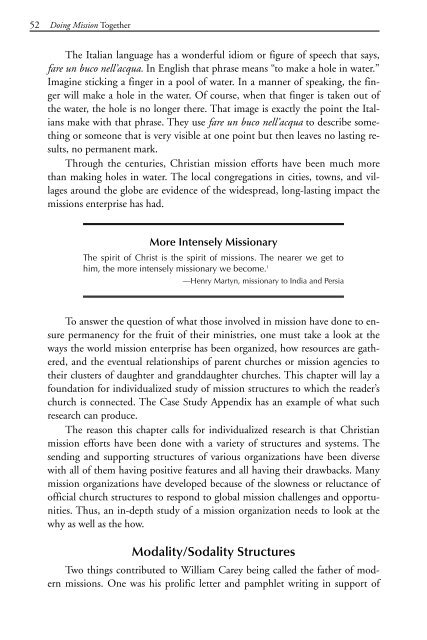discovering missions - Southern Nazarene University
discovering missions - Southern Nazarene University
discovering missions - Southern Nazarene University
Create successful ePaper yourself
Turn your PDF publications into a flip-book with our unique Google optimized e-Paper software.
245187 Disc Missions ins 9/6/07 1:04 PM Page 52<br />
52 Doing Mission Together<br />
The Italian language has a wonderful idiom or figure of speech that says,<br />
fare un buco nell’acqua. In English that phrase means “to make a hole in water.”<br />
Imagine sticking a finger in a pool of water. In a manner of speaking, the finger<br />
will make a hole in the water. Of course, when that finger is taken out of<br />
the water, the hole is no longer there. That image is exactly the point the Italians<br />
make with that phrase. They use fare un buco nell’acqua to describe something<br />
or someone that is very visible at one point but then leaves no lasting results,<br />
no permanent mark.<br />
Through the centuries, Christian mission efforts have been much more<br />
than making holes in water. The local congregations in cities, towns, and villages<br />
around the globe are evidence of the widespread, long-lasting impact the<br />
<strong>missions</strong> enterprise has had.<br />
More Intensely Missionary<br />
The spirit of Christ is the spirit of <strong>missions</strong>. The nearer we get to<br />
him, the more intensely missionary we become. 1<br />
—Henry Martyn, missionary to India and Persia<br />
To answer the question of what those involved in mission have done to ensure<br />
permanency for the fruit of their ministries, one must take a look at the<br />
ways the world mission enterprise has been organized, how resources are gathered,<br />
and the eventual relationships of parent churches or mission agencies to<br />
their clusters of daughter and granddaughter churches. This chapter will lay a<br />
foundation for individualized study of mission structures to which the reader’s<br />
church is connected. The Case Study Appendix has an example of what such<br />
research can produce.<br />
The reason this chapter calls for individualized research is that Christian<br />
mission efforts have been done with a variety of structures and systems. The<br />
sending and supporting structures of various organizations have been diverse<br />
with all of them having positive features and all having their drawbacks. Many<br />
mission organizations have developed because of the slowness or reluctance of<br />
official church structures to respond to global mission challenges and opportunities.<br />
Thus, an in-depth study of a mission organization needs to look at the<br />
why as well as the how.<br />
Modality/Sodality Structures<br />
Two things contributed to William Carey being called the father of modern<br />
<strong>missions</strong>. One was his prolific letter and pamphlet writing in support of

















